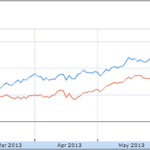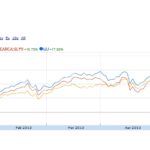In looking at 2010 stock market returns by country, we see some similar patterns to 2009, with higher beta emerging markets leading the pack. This top 20 list was constructed to give a sense of where the money was flowing in 2010 so as to inform where we may continue to see momentum, while at the same time, pointing out where risks of significant downside may appear in the event of another global equity correction like what we saw from 2008-2009. This list was constructed to focus primarily on individual country returns, but I included gulf states and some other joint regional ETFs since those individual countries aren’t represented by a standalone ETF. Leveraged ETFs were also excluded so as to not skew individual country return results, not to mention the fact they they make for terrible long-term investments (see why all leveraged ETFs go to zero).
Ticker/Return/Name
THDÂ Â Â 59Â Â Â %Â Â Â iShares MSCI Thailand Invest Mkt Index
EPUÂ Â Â 59Â Â Â %Â Â Â iShares MSCI All Peru Capped Index
GXGÂ Â Â 48Â Â Â %Â Â Â Global X/InterBolsa FTSE Colombia 20 ETF
ECHÂ Â Â 48Â Â Â %Â Â Â iShares MSCI Chile Investable Mkt Idx
IDXÂ Â Â 43Â Â Â %Â Â Â Market Vectors Indonesia Index ETF
EWMÂ Â Â 41Â Â Â %Â Â Â iShares MSCI Malaysia Index
EWDÂ Â Â 39Â Â Â %Â Â Â iShares MSCI Sweden Index
EZAÂ Â Â 37Â Â Â %Â Â Â iShares MSCI South Africa Index
EWYÂ Â Â 31Â Â Â %Â Â Â iShares MSCI South Korea Index
EWWÂ Â Â 29Â Â Â %Â Â Â iShares MSCI Mexico Investable Mkt Idx
GXFÂ Â Â 28Â Â Â %Â Â Â Global X FTSE Nordic 30 ETF
EWHÂ Â Â 27Â Â Â %Â Â Â iShares MSCI Hong Kong Index
TURÂ Â Â 27Â Â Â %Â Â Â iShares MSCI Turkey Invest Mkt Index
AFKÂ Â Â 26Â Â Â %Â Â Â Market Vectors Africa Index ETF
EWSÂ Â Â 25Â Â Â %Â Â Â iShares MSCI Singapore Index
MESÂ Â Â 25Â Â Â %Â Â Â Market Vectors Gulf States Index ETF
RSXÂ Â Â 24Â Â Â %Â Â Â Market Vectors Russia ETF
EWTÂ Â Â 24Â Â Â %Â Â Â iShares MSCI Taiwan Index
INPÂ Â Â 22Â Â Â %Â Â Â iPath MSCI India Index ETN
EWCÂ Â Â 21Â Â Â %Â Â Â iShares MSCI Canada Index
In assessing who the leaders are perennially in up markets, it should serve as a reminder of why you probably don’t have enough emerging markets exposure and how to get it. Being too US/EU-centric has its drawbacks, which is where most retirement plans are focused. One consideration of these returns is the ire flowing from emerging markets due to their view of QE2 distortions which will cause them to enact internal capital controls to stem the tide of cheap money flowing in. Following the QE2 announcement in November, Obama’s 2011 Tax Deal was essentially another stealth $900 Billion stimulus package that he wouldn’t have been able to pass on its own, furthering the concerns over cheap money and inflation elsewhere in the world. So, while these historical returns do appear to be attractive and the Wall Street consensus (CNBC) is that we’re going to see another year of strong returns in equities in 2011, be aware that many indicators are pointing toward a serious correction as well (exuberant individual investor flows, put/call ratios, the bond bubble deflating, EU debt contagion and more). With this in mind, just temper investments with hedges or small entries to avoid a crippling loss should we see a repeat of the last global equities collapse, where many emerging markets had declines in excess of 50% in a single year.
Personally, I like the prospects of Colombia (GXG) and Indonesia (IDX), but for broader exposure to very fast-growing emerging market economies minus the larger Indias and Chinas, it’s worth considering Frontier Markets. Many of these markets are growing at high single digit rates and don’t face the same debt problems western nations are struggling with presently.
Disclosure: Long GXG, IDX. No other holdings in ETFs discussed in this article.











{ 0 comments… add one now }